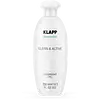What's inside
What's inside
 Benefits
Benefits

 Concerns
Concerns

 Ingredients Side-by-side
Ingredients Side-by-side

Water
Skin ConditioningCaprylic/Capric Triglyceride
MaskingSorbitol
HumectantPhenoxyethanol
PreservativePEG-40 Hydrogenated Castor Oil
EmulsifyingPEG-6 Stearate
EmulsifyingCarbomer
Emulsion StabilisingTrideceth-9
EmulsifyingGlycerin
HumectantSodium Hydroxide
BufferingEthylhexylglycerin
Skin ConditioningParfum
MaskingAloe Barbadensis Leaf Juice Powder
Skin ConditioningTetrasodium Glutamate Diacetate
Butylene Glycol
HumectantPropylene Glycol
HumectantSodium Benzoate
MaskingGlucose
HumectantUrtica Dioica Leaf Extract
Skin ConditioningPotassium Sorbate
PreservativeWater, Caprylic/Capric Triglyceride, Sorbitol, Phenoxyethanol, PEG-40 Hydrogenated Castor Oil, PEG-6 Stearate, Carbomer, Trideceth-9, Glycerin, Sodium Hydroxide, Ethylhexylglycerin, Parfum, Aloe Barbadensis Leaf Juice Powder, Tetrasodium Glutamate Diacetate, Butylene Glycol, Propylene Glycol, Sodium Benzoate, Glucose, Urtica Dioica Leaf Extract, Potassium Sorbate
Water
Skin ConditioningPEG-7 Glyceryl Cocoate
EmulsifyingCarbomer
Emulsion StabilisingDaucus Carota Sativa Juice
Skin ConditioningCarya Ovata Bark Extract
Skin ConditioningRosa Damascena Flower Oil
MaskingChondrus Crispus Extract
Skin ConditioningCymbopogon Martini Oil
MaskingNannochloropsis Oculata Extract
HumectantCinnamomum Camphora Leaf Oil
MaskingEthylhexylglycerin
Skin ConditioningSucrose Cocoate
EmulsifyingSorbitol
HumectantGlucose
HumectantCaprylic/Capric Triglyceride
MaskingBenzyl Acetate
MaskingPhenoxyethanol
PreservativeSodium Hydroxide
BufferingTetrasodium Glutamate Diacetate
Alpha-Ionone
PerfumingNonyl Nonoxynol-10
Citric Acid
BufferingPotassium Sorbate
PreservativeWater, PEG-7 Glyceryl Cocoate, Carbomer, Daucus Carota Sativa Juice, Carya Ovata Bark Extract, Rosa Damascena Flower Oil, Chondrus Crispus Extract, Cymbopogon Martini Oil, Nannochloropsis Oculata Extract, Cinnamomum Camphora Leaf Oil, Ethylhexylglycerin, Sucrose Cocoate, Sorbitol, Glucose, Caprylic/Capric Triglyceride, Benzyl Acetate, Phenoxyethanol, Sodium Hydroxide, Tetrasodium Glutamate Diacetate, Alpha-Ionone, Nonyl Nonoxynol-10, Citric Acid, Potassium Sorbate
Ingredients Explained
These ingredients are found in both products.
Ingredients higher up in an ingredient list are typically present in a larger amount.
This ingredient is an emollient, solvent, and texture enhancer. It is considered a skin-softener by helping the skin prevent moisture loss.
It helps thicken a product's formula and makes it easier to spread by dissolving clumping compounds.
Caprylic Triglyceride is made by combining glycerin with coconut oil, forming a clear liquid.
While there is an assumption Caprylic Triglyceride can clog pores due to it being derived from coconut oil, there is no research supporting this.
Learn more about Caprylic/Capric TriglycerideCarbomer is a polymer of acrylic acid. Its main role is to create a gel consistency.
A high amount of carbomer can cause pilling or balling up of products. Don't worry, most products contain 1% or less of carbomer.
Ethylhexylglycerin (we can't pronounce this either) is commonly used as a preservative and skin softener. It is derived from glyceryl.
You might see Ethylhexylglycerin often paired with other preservatives such as phenoxyethanol. Ethylhexylglycerin has been found to increase the effectiveness of these other preservatives.
Glucose is a simple sugar and is the most important source of energy in all organisms.
In skincare, glucose is used to hydrate the skin. It also acts as a prebiotic for our natural biome.
Glucose is hydrating due to its humectant property. As a humectant, glucose draws moisture from the air and from deeper levels in the skin.
Our skin contains many sugars that act as prebiotics and help strengthen our natural microbiome. Having a healthy microbiome helps protect our skin from harmful bacteria and other contaminants.
Studies show glucose may help with fading discoloration and pigmentation. This is because our skin metabolizes glucose into lactic acid. Lactic acid is an AHA that helps exfoliate the top layer of skin.
Learn more about GlucosePhenoxyethanol is a preservative that has germicide, antimicrobial, and aromatic properties. Studies show that phenoxyethanol can prevent microbial growth. By itself, it has a scent that is similar to that of a rose.
It's often used in formulations along with Caprylyl Glycol to preserve the shelf life of products.
Potassium Sorbate is a preservative used to prevent yeast and mold in products. It is commonly found in both cosmetic and food products.
This ingredient comes from potassium salt derived from sorbic acid. Sorbic acid is a natural antibiotic and effective against fungus.
Both potassium sorbate and sorbic acid can be found in baked goods, cheeses, dried meats, dried fruit, ice cream, pickles, wine, yogurt, and more.
You'll often find this ingredient used with other preservatives.
Learn more about Potassium SorbateSodium Hydroxide is also known as lye or caustic soda. It is used to adjust the pH of products; many ingredients require a specific pH to be effective.
In small amounts, sodium hydroxide is considered safe to use. However, large amounts may cause chemical burns due to its high alkaline.
Your skin has a natural pH and acid mantle. This acid mantle helps prevent harmful bacteria from breaking through. The acid mantle also helps keep your skin hydrated.
"Alkaline" refers to a high pH level. A low pH level would be considered acidic.
Learn more about Sodium HydroxideSorbitol is a sugar alcohol. It is a hydrating and moisturizing agent created from the reduction process of glucose.
Most sorbitol is usually made from potato starch. It is also found in fruits such as apples and pears.
As a humectant, Sorbitol helps draw water to the skin. This helps keep the skin hydrated. Sorbitol also helps create a thicker texture in products. You might find sorbitol in your toothpaste and other gels.
It is a non-irritating ingredient that is great for those with dry skin.
Sorbitol is a prebiotic. It helps promote the growth of healthy bacteria on your skin. The bacteria on your skin form a microbiome. This microbiome helps protect your skin from infection and harmful bacteria.
Learn more about SorbitolTetrasodium Glutamate Diacetate is a chelating agent. Chelating agents help prevent metal ions from binding to other ingredients. This helps prevent unwanted effects and reactions from a product. These metal ions may come from water and are found in miniscule amounts.
Tetrasodium Glutamate Diacetate can also help other preservatives be more effective.
Water. It's the most common cosmetic ingredient of all. You'll usually see it at the top of ingredient lists, meaning that it makes up the largest part of the product.
So why is it so popular? Water most often acts as a solvent - this means that it helps dissolve other ingredients into the formulation.
You'll also recognize water as that liquid we all need to stay alive. If you see this, drink a glass of water. Stay hydrated!
Learn more about Water